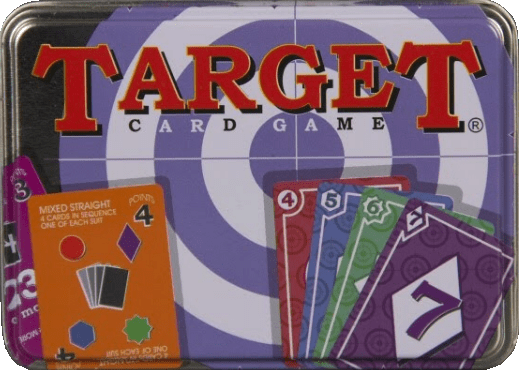If you’re like me, you’ve probably spent way too much time searching for the next good board game to play with your friends. Well, you’re in luck (or maybe about to get unlucky, depending how this goes)! This is my review of the board game Target. I’ve played it a bunch, accidentally flung pieces across the room, and yes, forced my friends to try every player count. Here’s the honest run-down—without any marketing fluff, just one gamer’s real experience (plus some questionable snacks).
How It Plays
Setting up
Put the board in the middle of the table, give each player their color’s set of discs, and shuffle the target cards. Place the cards face down. Everyone gets a trusty scoring sheet. Super easy—you’ll be ready to start before your friend finishes making their snack.
Gameplay
On your turn, flip a target card. The card shows which spot to aim for on the board. Players take turns flicking or tossing their discs, trying to land closest to the target spot. There’s a little skill and a lot of friendly trash talk. Watch out for wild ricochets—my cousin actually hit my juice box last time. After everyone’s had a shot, score the round, then draw a new card and go again.
Winning the game
Keep track of points after each round. When all the target cards are used, the player with the most points wins. Celebrate with your best victory dance. Losing? Blame your wobbly table. (Hey, it works for me.)
Want to know more? Read our extensive strategy guide for Target.
Setting Up Target and Judging Its Bits: A Hands-On Guide
First things first, let’s talk about opening the box for Target. I swear, it felt like unwrapping a mystery present from my Aunt Linda, except I didn’t have to pretend to love it. The contents are pretty sturdy. You’re greeted with a stack of cards, some chunky wooden tokens, and a board that doesn’t feel like it’s made of recycled tissue. The colors? Bright enough to put my sad kitchen wallpaper to shame. Whoever picked them must moonlight as a birthday clown.
Setup is quick, which is great for impatient folks like me who’d rather eat cardboard than read ten pages of instructions. Each player grabs their tokens, shuffles their cards, and everyone’s good to go before you can say, “Who shuffled these cards, a raccoon?” Seriously, you’re looking at maybe five minutes, tops, before the game starts. It’s almost impossible to mess up setup, unless you’re like my friend Greg who somehow managed to sit on a pile of tokens and then blamed my cat.
The component quality in Target is impressive for its price. Cards feel sturdy, and the tokens have a nice weight. The board sits flat and doesn’t curl at the corners like a nervous hedgehog. I did notice the art leans a bit more ‘functional’ than ‘inspiring’—no Renaissance masterpieces here, but at least everything is clear. No tiny text or ambiguous symbols to make you squint.
For folks like me who can’t stand games with thirty-minute setups or flimsy pieces, Target actually scores pretty well. Next up, though, the real test: can you figure out how to play Target without melting your brain? Let’s see if the rules make sense or if we’ll need a degree in ancient languages.
Rules Clarity and Learning Curve in Target
Now, let’s talk about the rulebook in Target. If you’ve ever opened a board game and felt like you were reading ancient scrolls in Klingon, fear not! Target keeps things blessedly simple. The rulebook is slim. And for once, that’s a good thing. My friends and I sat down, and within fifteen minutes, we had sorted out the main rules and were already arguing about who gets to go first (as usual, I lost).
Every action in Target is clear. You don’t need a law degree or a magnifying glass. The instructions use plain language, with helpful pictures and easy-to-follow examples. There was only one rule we had to discuss twice—and that was probably because we were distracted by the snacks and not because of the game itself. Target even includes a one-page quick-start guide. That little sheet saved us from a few classic “wait, are we doing this right?” moments.
Teaching Target to new players is a breeze. Even my friend Dave, who still gets stuck on Uno rules, picked this up faster than he picks toppings off his pizza. After one practice round, everyone felt confident. There’s hardly any jargon, and you don’t have to keep flipping back through the manual mid-game. The only thing you’ll be flipping is your strategy (and maybe the table, but only if you take losing badly).
Next up, I’ll pull back the curtains and reveal how well Target balances luck and strategy—because nobody wants to win just by rolling the right number, right?
Is Target Fair? Luck vs. Strategy in the Hot Seat
When my friends and I first sat down to play Target, I had big hopes. I mean, who doesn’t like outsmarting their pals? But, heads up: Target is a bit of a mixed bag when it comes to luck and skill. I’d say, it feels like rolling dice inside your own brain. That might not make sense yet, but stay with me.
Let’s start with the good stuff. You can plan and scheme in Target. There are moments when you get that sweet taste of victory knowing you set the perfect trap. That’s satisfying, and it’s clear the designers want you to use your head. Sometimes, you can bluff your way past even the most eagle-eyed cousin at the table. I almost felt smart. Almost.
But, and this is a big but, luck still sneaks in like a raccoon in your garbage can. You draw a random card or roll, and sometimes it just tanks your amazing plan. One round, my friend Carla won because she drew three perfect cards in a row. I wanted to flip the table and change my name. If you want a game that’s all brains, Target might make you grow a few gray hairs.
It’s not totally unfair, but if seeing your careful planning smashed by random chance sends you to angry town, take note. I’d give Target 3 out of 5 stars in this part. Fun, but not for control freaks (hi, that’s me!).
Speaking of control, how well does Target hold up on repeat plays and with different crowds? Let’s shuffle over to its replay value next—you’ll want to read this before busting it out at game night!
Replay Value: Does Target Stand the Test of Time and Player Numbers?
Let’s get real for a second. Some board games are like my aunt’s pineapple casserole—fun once, then you’re good for a year. Not so with Target. I hauled this game out for four totally different game nights. First, we had a two-player duel. Next, three. Then, a rambunctious four-person round. Last, that sad little session where I tried to play with my cat. (Cats are not great at board games.)
Target holds up remarkably well across all group sizes. With two players, it turns into a tense stare-down—every move matters, and there’s nowhere to hide your mistakes. Sometimes I felt like I was playing chess, but with more giggles and less existential dread. The three-player setup gets a bit wild. Alliances form, break, and suddenly your buddy is out for your blood over a lost point. With four, it’s party mode. The board gets crowded, tactics become unpredictable, and chaos reigns. But not the ‘throw the board across the room’ kind of chaos. Just the good, fun kind.
What about replay value? I have to say, Target kept us coming back. The simple rules mean new folks can join in without a long teaching session, and game sessions go quick enough that you can fit in rematches before your pizza gets cold. The board doesn’t really change, but the player dynamics do, and that’s what gives Target its replay legs. If you get bored easily, you’ll find enough variety in the people you play with.
So, would I recommend Target? Totally. Unless you’re only looking for deep strategy, Target is a keeper for lots of group sizes. Now, if only my cat would take her turns on time…
Conclusion
So that’s my review of Target! If you like fast games that don’t take ages to set up, you’ll have a good time flicking those discs. The components look nice and the rules are clear. I just wish luck didn’t mess things up sometimes. If you want a fun party game with friends or family, Target is a solid choice. But if you hate randomness, you might get frustrated. Thanks for reading, and may your disc always land on the bullseye!


